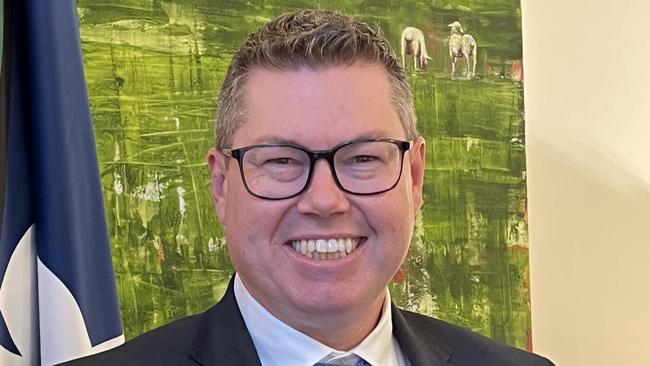Defence Industry Minister Pat Conroy on why Australia needs advanced technology, ready to use and deploy
Working at the cutting edge of strategic research, our researchers, scientists and innovators are generating technologies that will safeguard our national security as we face the challenges ahead.

The talented researchers, scientists and innovators who work with and within Australia's Defence Force and supporting industries are vital to the safety of our nation.
They are respected around the world for their proven ability to generate, sustain and future-proof Australia’s military capability.
Working at the cutting edge of strategic research, they are generating technologies that will safeguard our national security as we face the challenges ahead.
And those challenges are significant. Not since World War II has Australia faced such geopolitical uncertainty. The global rules-based order that we depend on for our security and prosperity is under immense pressure.
And closer to home, in our own Indo-Pacific region, we are witnessing increased strategic competition between nations.
Australia must adapt to the world as it really is.
That means understanding that the great strategic blessing of our island continent – and the three oceans that buffer us from the world – is diminishing, largely as a result of developments in technology, including longer-range missiles, hypersonics and cyber-attacks.
Russia’s invasion of Ukraine has also underscored the importance of robust supply chains and getting game-changing technology into the hands of the war fighter at a much faster pace.
With strategic warning times shrinking, we need advanced technology to be ready to use and deploy if we are to effectively deter threats against Australia and our national interests.
The Albanese government has begun the necessary transformation of our defence capability to help ensure the Australian Defence Force (ADF) has the capability, the technology, the people and the funding it needs to keep Australians safe.
The first critical piece of work was the announcement with our AUKUS partners, the UK and the US, of the optimal pathway for Australia to acquire conventionally armed, nuclear-powered submarines.
We will build, operate, maintain and regulate this potent military capability in Australia.
Success will depend on thousands of highly skilled Australian scientists, engineers, project managers, operators, technicians, welders, construction workers, electricians, metal fitters and builders.
Work has already begun with Australian universities and the vocational sector to create and shape the courses that will deliver the knowledge and skills we need to bring this endeavour to fruition.
We are taking a sustained, whole-of-government approach to build up the national workforce needed for our naval shipbuilding and conventionally armed, nuclear-powered submarine ambitions. This means working with state and territory governments, unions and employers.
This month, the government will release the Defence Strategic Review and the government’s formal response to it, which will form the blueprint for defence thinking for decades to come.
And it will inform the government’s new Defence Industry Development Strategy, which will set the framework and principles for the direction of defence industry policy for what will be a consequential decade for Australia’s national security.
This will grow Australia’s defence industry, which supports 61,600 Australian jobs and contributes more than $10.6bn to the Australian economy.
As we look to advance our defence capabilities, our partnerships in industry and technology will be vitally important.
Our partnerships have delivered autonomous capabilities and innovative technologies, such as the MQ-28 Ghost Bat, Ghost Shark XL-AUV and Ocius Bluebottle. These capabilities demonstrate Australian ingenuity and the government’s commitment to collaborate with industry on cutting-edge technologies.
As potent and able as Australia’s defence innovation system undoubtedly is, the challenges we face mean that Defence must rapidly transform the way it pulls innovation through to capability; to make it happen faster and on a bigger scale than ever before.
We’ve looked closely at the world-leading innovation funded and created by DARPA, the special-projects research arm of the US Department of Defense, and ARIA, the UK government’s Advanced Research and Invention Agency, launched last year.
We see it as essential that the government supports the development and pull-through of ambitious and asymmetric innovations that will deliver and maintain the highest level of military capability, and scientific and technological sophistication.
I’ll soon announce details of the organisation that will fund and co-ordinate mission-directed capability development aligned to Defence’s highest priority challenges. It will turbocharge the pathway from proposal to prototype to production. It will ensure cutting-edge capability innovation from public sources such as universities and industry, including classified capability, are supported and co-ordinated.
And it will help ensure that we make the most of our AUKUS partnership, which goes well beyond nuclear-powered propulsion technology to progress specific advanced capability initiatives.
Australia, the UK and the US are pursuing six lines of effort: artificial intelligence, advanced cyber, quantum computing, undersea capabilities, hypersonics and counter-hypersonics, and electronic warfare.
The government is determined that Australia will play its part in developing and producing the capabilities that will safeguard and protect us and our partners.
Inside the pages of this supplement you’ll see examples of homegrown, cutting-edge innovation and collaboration that are rapidly changing the face of Australia’s defence capabilities.
Spanning air, space, land and water, these technologies are transforming the ADF into a much more potent deterrent.
We need to be better able to deter conflict, and in the worst-case scenario, defend ourselves, sustain our operations, and increase the cost for aggressors who act against our shared interests.
At the end of the day, that is the purpose of the government’s continuing investment in Defence science and technology – to keep Australia safe.
-
Pat Conroy is Minister for Defence Industry and Minister for International Development and the Pacific.


